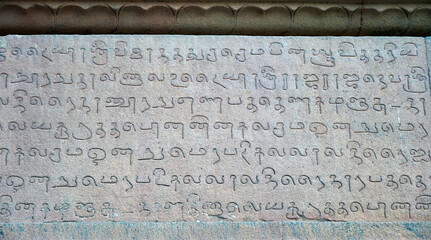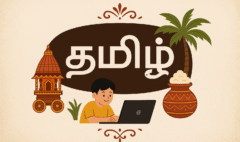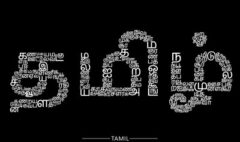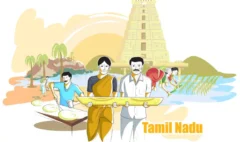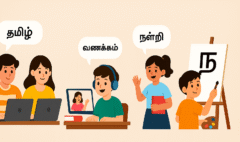How to Talk About Your Family History in Tamil
How to Talk About Your Family History in Tamil
How to Talk About Your Family History in Tamil: A Guide to Your Roots
Our family history is the story of who we are. It is the thread that connects us to our past, that shapes our present, and that we pass on to our future generations. The stories of our ancestors—their lives, their struggles, and their triumphs—are a fundamental part of our own identity. For those of us who are a part of the Tamil diaspora or for anyone who wishes to connect more deeply with their roots, being able to talk about your Tamil family history (குடும்ப வரலாறு – Kuṭumpa varalāṟu) in the Tamil language is a profoundly meaningful and rewarding endeavor. It is a way of honoring your cultural heritage and of keeping the memories of your ancestors alive.
This guide is designed to provide you with the essential vocabulary and the simple phrases you need for talking about ancestors in Tamil. We will cover the key words for family relationships that extend back through the generations and will give you the tools to start building and describing your own family tree in Tamil (குடும்ப மரம் – Kuṭumpa maram). This is more than just a language lesson; it is a journey into your own personal history.
Part 1: The Core Vocabulary of Ancestry
Let’s start with the most important words that form the foundation of any discussion about family history.
- Family – குடும்பம் (Kuṭumpam)
- History – வரலாறு (Varalāṟu)
- Ancestors – முன்னோர்கள் (Muṉṉōrkaḷ)
- Generation – தலைமுறை (Talaimuṟai)
- Heritage / Tradition – பாரம்பரியம் (Pārampariyam)
- Roots – வேர்கள் (Vērkaḷ)
- Native Place / Ancestral Village – சொந்த ஊர் (Conta ūr)
Part 2: Building Your Family Tree – The Key Relationships
The Tamil language has a beautifully specific and logical system for naming family members, which is much more detailed than in English. Let’s go back through the generations.
Your Grandparents’ Generation:
- Grandfather – தாத்தா (Tāttā)
- Grandmother – பாட்டி (Pāṭṭi)
- Great-grandfather – கொள்ளுத் தாத்தா (Koḷḷut tāttā)
- Great-grandmother – கொள்ளுப் பாட்டி (Koḷḷup pāṭṭi)
Your Parents’ Generation:
- Father – அப்பா (Appā)
- Mother – அம்மா (Ammā)
- Father’s Elder Brother – பெரியப்பா (Periyappā)
- Father’s Younger Brother – சித்தப்பா (Cittappā)
- Mother’s Elder Sister – பெரியம்மா (Periyammā)
- Mother’s Younger Sister – சித்தி (Citti)
- Father’s Sister – அத்தை (Attai)
- Mother’s Brother – மாமா (Māmā)
Your Generation:
- Elder Brother – அண்ணன் (Aṇṇaṉ)
- Younger Brother – தம்பி (Tampi)
- Elder Sister – அக்கா (Akkā)
- Younger Sister – தங்கை (Taṅkai)
– Cousin (male) – அண்ணன்/தம்பி (Aṇṇaṉ/Tampi) – The same words for brother are used, depending on whether the cousin is older or younger.
– Cousin (female) – அக்கா/தங்கை (Akkā/Taṅkai) – The same words for sister are used.
Your Children’s Generation:
- Son – மகன் (Makaṉ)
- Daughter – மகள் (Makaḷ)
- Grandson – பேரன் (Pēraṉ)
- Granddaughter – பேத்தி (Pētti)
Part 3: Phrases for Talking About Your Ancestors
Now that you have the vocabulary, here are some simple sentence structures to help you start telling your family’s story.
Stating Origins:
- “My ancestors are from…” – “என் முன்னோர்கள் …-லிருந்து வந்தவர்கள்.” (Eṉ muṉṉōrkaḷ …-liruntu vantavarkaḷ.)
Example: “என் முன்னோர்கள் தஞ்சாவூரிலிருந்து வந்தவர்கள்.” (Eṉ muṉṉōrkaḷ tañcāvūriliruntu vantavarkaḷ.) – “My ancestors are from Thanjavur.” - “Our ancestral village is…” – “எங்கள் சொந்த ஊர்…” (Eṅkaḷ conta ūr…)
- “My grandfather was a…” – “என் தாத்தா ஒரு …-ஆக இருந்தார்.” (Eṉ tāttā oru …-āka iruntār.)
Example: “என் தாத்தா ஒரு விவசாயியாக இருந்தார்.” (Eṉ tāttā oru vivacāyiyāka iruntār.) – “My grandfather was a farmer.” - “My grandmother’s name was…” – “என் பாட்டியின் பெயர்…” (Eṉ pāṭṭiyiṉ peyar…)
Describing a Timeline:
- “My great-grandfather was born in the year…” – “என் கொள்ளுத் தாத்தா …-ஆம் ஆண்டு பிறந்தார்.” (Eṉ koḷḷut tāttā …-ām āṇṭu piṟantār.)
- “They lived there for many generations.” – “அவர்கள் பல தலைமுறைகளாக அங்கு வசித்தார்கள்.” (Avarkaḷ pala talaimuṟaikaḷāka aṅku vacittārkaḷ.)
Telling a Simple Story:
You can start to weave the vocabulary into a simple narrative.
“என் கொள்ளுத் தாத்தா பெயர் ராமு. அவர் ஒரு விவசாயி. அவர் மதுரைக்கு அருகில் ஒரு சிறிய கிராமத்தில் வசித்தார். அவருக்கு நான்கு மகன்கள். என் தாத்தா அவர்களில் இளையவர்.”
(Eṉ koḷḷut tāttā peyar Rāmu. Avar oru vivacāyi. Avar maturaikku arukaiyil oru ciṟiya kirāmattil vacittār. Avarukku nāṉku makaṉkaḷ. Eṉ tāttā avarkaḷil iḷaiyavar.)
Translation: “My great-grandfather’s name was Ramu. He was a farmer. He lived in a small village near Madurai. He had four sons. My grandfather was the youngest among them.”
Tips for Discovering and Sharing Your Family History
- Talk to Your Elders: This is the most important step. Sit down with your parents, your grandparents, your aunts, and your uncles. Ask them to tell you stories about their own childhood and about the ancestors they remember. Record these conversations if you can. These oral histories are a precious and irreplaceable part of your cultural heritage.
– Look at Old Photographs: Old family photos are a powerful prompt for storytelling. Go through an old album with a relative and ask them, “இது யார்?” (Itu yār?) – “Who is this?” “இந்த புகைப்படம் எங்கே எடுக்கப்பட்டது?” (Inta pukaippaṭam eṅkē eṭukkappaṭṭatu?) – “Where was this photograph taken?”
– Draw a Family Tree: A wonderful project to do with your children is to create a visual family tree in Tamil. Use the Tamil words for the different family members. This is a fantastic way to teach them the vocabulary and to help them to visualize their own place in the family’s long history.
Conclusion: A Story that Lives Within You
The journey into your Tamil family history is a journey of self-discovery. It is a process that connects you to the generations that came before you and gives you a deeper sense of your own roots and your own identity. The language is the key that unlocks these stories. By talking about ancestors in Tamil, you are not just practicing a language; you are breathing life into the memories of your past. You are honoring your heritage, and you are creating a precious legacy to pass on to your own children. It is one of the most personal, profound, and powerful ways to connect with the Tamil language.

